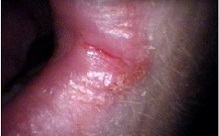Corner inflammation of the mouth
| Classification according to ICD-10 | |
|---|---|
| K13.0 | Diseases of the lips |
| ICD-10 online (WHO version 2019) | |
A mouth inflammation (also: mouth rhagade angular cheilitis, Angulus infectiosus oris, Perlèche, [ French pourlècher , lick their lips] or Perleche ) is a disease of the skin and mucous membrane of the mouth.
etiology
There are currently (2016) hardly any scientific studies on the frequency of the disease (prevalence) and its causes ( etiology ). The assumption that inflammation of the corner of the mouth is related to a large number of local and systemic factors is based on medical experience. These local and systemic factors can occur individually or in combination.
Local causes
As the most common underlying causes, there are three local causes:
- Local contact dermatitis due to anatomically conditioned mechanical or chemical stimuli
- Allergic contact dermatitis
- Infectious causes (for example, a fungal infection with Candida albicans or a bacterial infection with Staphylococcus aureus )
Systemic causes
Systemic causes can be other underlying diseases, malnutrition, substance abuse or medication. It is believed that in about a quarter of cases the cause is a deficiency in B vitamins (riboflavin (vitamin B 2 ), pyridoxine (vitamin B 6 ), biotin (vitamin B 7 ) and cobalamin (vitamin B 12 )) or Iron lies.
It is believed that iron deficiency leads to immune deficiency and that this leads to opportunistic Candida infections.
Similarly, zinc deficiency is a known cause, which also cause diarrhea, hair loss and dermatitis leads. Acrodermatitis enteropathica is a congenital metabolic disorder that leads to reduced zinc absorption and is therefore associated with inflammation of the corner of the mouth.
Corner infections most commonly occur in the third, fifth and sixth decades of life. In adults, they account for 0.7 to 3.8% of all mucosal lesions. In children, it is 0.2 to 15.1% of all oral lesions.
Symptoms
Symptoms are general signs of inflammation , maceration , ulceration, and crusting. An inflammation of the corner of the mouth can develop on one or both sides at the same time. The onset can be gradual or acute. The course can remit spontaneously or be recurring.
therapy
The mainstay of the first treatment is to remove the causes known as local triggers for the damage to the skin around the corners of the mouth. The aim is to prevent a chronic course.
Treatment of local causes includes:
- Ensuring the correct fit and correct cleaning of dentures
- Ensuring proper oral hygiene
- Use of saliva substitutes (sialogoga) if necessary
- Protective cream as a barrier in the evening (e.g. zinc oxide paste)
These measures are usually enough to achieve relief. When all options for treating local causes have been exhausted, less common causes of corneritis should be identified.
See also
Individual evidence
- ↑ a b c d e f g h i j k l m n o p q Kelly. K. Park, Robert T. Brodell, Stephen E. Helms: Angular cheilitis, part 1: local etiologies. In: Cutis . tape 87 , no. 6 , June 2011, p. 289-295 , PMID 21838086 (review).
- ↑ a b Perlèche. (No longer available online.) In: The online encyclopedia of dermatology, venereology, allergology and environmental medicine. P. Altmeyer. Archived from the original on April 3, 2015 ; Retrieved June 25, 2016 .
- ↑ Dorothea Terhorst (Ed.): Basics Dermatology . 2nd Edition. Elsevier, Urban & Fischer, 2009, ISBN 978-3-437-42137-2 , pp. 129-130 .
- ^ WC Gonsalves, AS Wrightson, RG Henry: Common oral conditions in older persons. In: American family physician . tape 78 , no. 7 , October 2008, p. 845-852 , PMID 18841733 (review).
- ↑ a b c d e Kelly K. Park, Robert T. Brodell, Stephen E. Helms: Angular cheilitis, part 2: nutritional, systemic, and drug-related causes and treatment. In: Cutis . tape 88 , no. 1 , July 2011, p. 27-32 , PMID 21877503 (review).
- ↑ Ulrich Hengge, Thomas Ruzicka (ed.): Textbook of dermatology and venereology. Your red thread through studies according to the new ÄAppO . Wissenschaftliche Verlagsgesellschaft, Stuttgart 2006, ISBN 978-3-8047-2178-4 .
- ↑ Gaveau D, Piette F, Cortot A, Dumur V, Bergoend H: [Cutaneous Manifestations of zinc deficiency in ethylic cirrhosis] . In: Ann Dermatol Venereol . 114, No. 1, 1987, pp. 39-53. PMID 3579131 .


